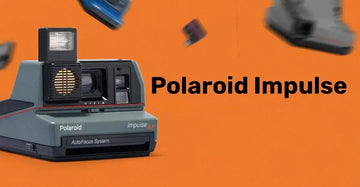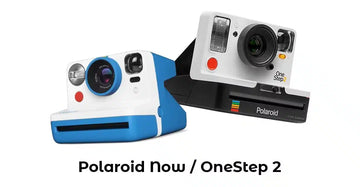
Today we are going to talk about one of the most underrated Polaroid camera series, and probably the best camera for beginners – Impulse.
The Impulse series was released in 1988, but it got lost among the many Polaroid camera models that existed at the time (various 600-type cameras, SX-70, and Spectra). Production of the Impulse cameras was discontinued in 1994.
This camera uses Polaroid 600-series integral film. The Impulse differs from other Polaroid 600-series cameras by its always-on flash, binocular-style design, and larger viewfinder.
Among the models were the basic Impulse camera as well as Polaroid Portrait, AF, SE, SE AF, CL and QPS – many letters, but little information?
So, let's try to figure it out, and we will be helped by this charming table:
| Model | Lens Type | Self-Timer |
| Impulse | Fixed-focus lens | No |
| Impulse Portrait | Fixed-focus lens with two selectable focusing zones | No |
| Impulse CL | Fixed-focus lens with two selectable focusing zones | No |
| Impulse AF | Autofocus | Yes |
| Impulse SE | Fixed-focus lens | No |
| Fixed-focus lens with two selectable focusing zones | No | |
| Autofocus | Yes | |
| Impulse QPS | Fixed-focus lens | No |
| Fixed-focus lens with two selectable focusing zones | No |
All the cameras are very similar to each other, but we can highlight three types that we will focus on: basic Impulse, Impulse Portrait, and Impulse AF.
Polaroid Impulse

The basic Polaroid Impulse model is quite an average camera with a fixed focus and a minimum focusing distance of 1.2 meters. However, it really attracted attention with its design. For the first time in many years, the company released a non-folding camera (it somewhat resembles the design of the SX-70 box-type camera), but more futuristic. To turn on the camera, you need to press a button on the top of the body that activates the flash. It is very easy to use, with only an exposure compensation slider as the setting. Near the shutter button, there is a light indicator, which signals the camera is ready to take a picture with a green light.
Polaroid Impulse Portrait

In the Portrait, CL, QPS and SE versions, there was already a macro lens for portraits that could be attached to the basic lens. The portrait lens switch is located on the top of the body. When the lens is extended, a frame with an oval appears in the viewfinder, and the person's face should be placed inside the oval during the photo. In this case, the focusing for portrait photography was optimized. The presence of the portrait lens makes the Portrait much more interesting and versatile, but in all other aspects, it completely repeats the basic model. As with other cameras in the Impulse series, the flash cannot be turned off; in some situations, this can be a drawback and lead to poor photos. The only way to turn off the built-in flash is to cover it with your hand.
Polaroid Impulse AF

We have now reached the best camera in the series – Impulse AF. The Polaroid camera that combines the features of SX-70, Spectra, and 600-series cameras . Autofocus is achieved using sonar technology, which delivers amazing results. The Impulse AF has a tripod socket that allows the camera to be placed on a surface for stable shooting. It is also the only 600-series camera that has a built-in self-timer button, which is located where the portrait lens switch is in the Portrait version. After pressing the self-timer button, a 10-second timer is activated, accompanied by a light signal on the front panel of the camera, between the viewfinder window and the lens. Some black models, in addition to the self-timer button, also feature a remote control port compatible with the Polaroid Spectra remote control system, in case 10 seconds is not enough for you. And of course, there’s the large viewfinder, which is present in all models of the series.
Also, in our opinion, the coolest feature of the Impulse cameras is the color designs. Usually, Polaroid camera color options were limited to black, gray, and occasionally white (not counting small colorful design elements). In addition to standard black and gray models, bright blue, bright yellow, jade green, and cherry red options were added. However, this color variety is only available for the basic and AF models.

In conclusion, it can be said that these cameras are truly targeted at different audiences, as the cameras in the series were radically different – from the quite average fixed-focus camera to the cool sonar-equipped one. However, they never gained wild popularity, although they are truly a quality and cool product. Today, the market is filled with various Impulse models, making them a very affordable option for beginners. You can also order a Polaroid Impulse from us and realize that this camera is truly cool and worth the attention.




